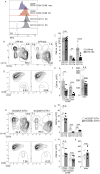Th17 Immunity in the Colon Is Controlled by Two Novel Subsets of Colon-Specific Mononuclear Phagocytes
- PMID: 33995384
- PMCID: PMC8113646
- DOI: 10.3389/fimmu.2021.661290
Th17 Immunity in the Colon Is Controlled by Two Novel Subsets of Colon-Specific Mononuclear Phagocytes
Abstract
Intestinal immunity is coordinated by specialized mononuclear phagocyte populations, constituted by a diversity of cell subsets. Although the cell subsets constituting the mononuclear phagocyte network are thought to be similar in both small and large intestine, these organs have distinct anatomy, microbial composition, and immunological demands. Whether these distinctions demand organ-specific mononuclear phagocyte populations with dedicated organ-specific roles in immunity are unknown. Here we implement a new strategy to subset murine intestinal mononuclear phagocytes and identify two novel subsets which are colon-specific: a macrophage subset and a Th17-inducing dendritic cell (DC) subset. Colon-specific DCs and macrophages co-expressed CD24 and CD14, and surprisingly, both were dependent on the transcription factor IRF4. Novel IRF4-dependent CD14+CD24+ macrophages were markedly distinct from conventional macrophages and failed to express classical markers including CX3CR1, CD64 and CD88, and surprisingly expressed little IL-10, which was otherwise robustly expressed by all other intestinal macrophages. We further found that colon-specific CD14+CD24+ mononuclear phagocytes were essential for Th17 immunity in the colon, and provide definitive evidence that colon and small intestine have distinct antigen presenting cell requirements for Th17 immunity. Our findings reveal unappreciated organ-specific diversity of intestine-resident mononuclear phagocytes and organ-specific requirements for Th17 immunity.
Keywords: Th17 immunity; colon; dendritic cells; intestine; macrophages; small intestine.
Copyright © 2021 Huang, Jewell, Youssef, Huang, Hauser, Fee, Rudemiller, Privratsky, Zhang, Reyes, Wang, Taylor, Gunn, Ko, Cook, Chandramohan, Crowley and Hammer.
Conflict of interest statement
The authors declare that the research was conducted in the absence of any commercial or financial relationships that could be construed as a potential conflict of interest.
Figures





Similar articles
-
Functional specializations of intestinal dendritic cell and macrophage subsets that control Th17 and regulatory T cell responses are dependent on the T cell/APC ratio, source of mouse strain, and regional localization.J Immunol. 2011 Jul 15;187(2):733-47. doi: 10.4049/jimmunol.1002701. Epub 2011 Jun 10. J Immunol. 2011. PMID: 21666057 Free PMC article.
-
CCR2(+)CD103(-) intestinal dendritic cells develop from DC-committed precursors and induce interleukin-17 production by T cells.Mucosal Immunol. 2015 Mar;8(2):327-39. doi: 10.1038/mi.2014.70. Epub 2014 Aug 20. Mucosal Immunol. 2015. PMID: 25138666 Free PMC article.
-
Subsets of mononuclear phagocytes are enriched in the inflamed colons of patients with IBD.BMC Immunol. 2019 Nov 12;20(1):42. doi: 10.1186/s12865-019-0322-z. BMC Immunol. 2019. PMID: 31718550 Free PMC article.
-
Intestinal macrophages and dendritic cells: what's the difference?Trends Immunol. 2014 Jun;35(6):270-7. doi: 10.1016/j.it.2014.04.003. Epub 2014 Apr 30. Trends Immunol. 2014. PMID: 24794393 Review.
-
Human mononuclear phagocyte system reunited.Semin Cell Dev Biol. 2015 May;41:59-69. doi: 10.1016/j.semcdb.2015.05.004. Epub 2015 May 15. Semin Cell Dev Biol. 2015. PMID: 25986054 Review.
Cited by
-
The intestinal immune system and gut barrier function in obesity and ageing.FEBS J. 2023 Sep;290(17):4163-4186. doi: 10.1111/febs.16558. Epub 2022 Jul 1. FEBS J. 2023. PMID: 35727858 Free PMC article. Review.
-
Abnormal Changes of Monocyte Subsets in Patients With Sjögren's Syndrome.Front Immunol. 2022 Mar 4;13:864920. doi: 10.3389/fimmu.2022.864920. eCollection 2022. Front Immunol. 2022. PMID: 35309355 Free PMC article.
-
Dendritic cell functions in the inductive and effector sites of intestinal immunity.Mucosal Immunol. 2022 Jan;15(1):40-50. doi: 10.1038/s41385-021-00448-w. Epub 2021 Aug 31. Mucosal Immunol. 2022. PMID: 34465895 Review.
References
Publication types
MeSH terms
Substances
Grants and funding
LinkOut - more resources
Full Text Sources
Other Literature Sources
Molecular Biology Databases
Research Materials

